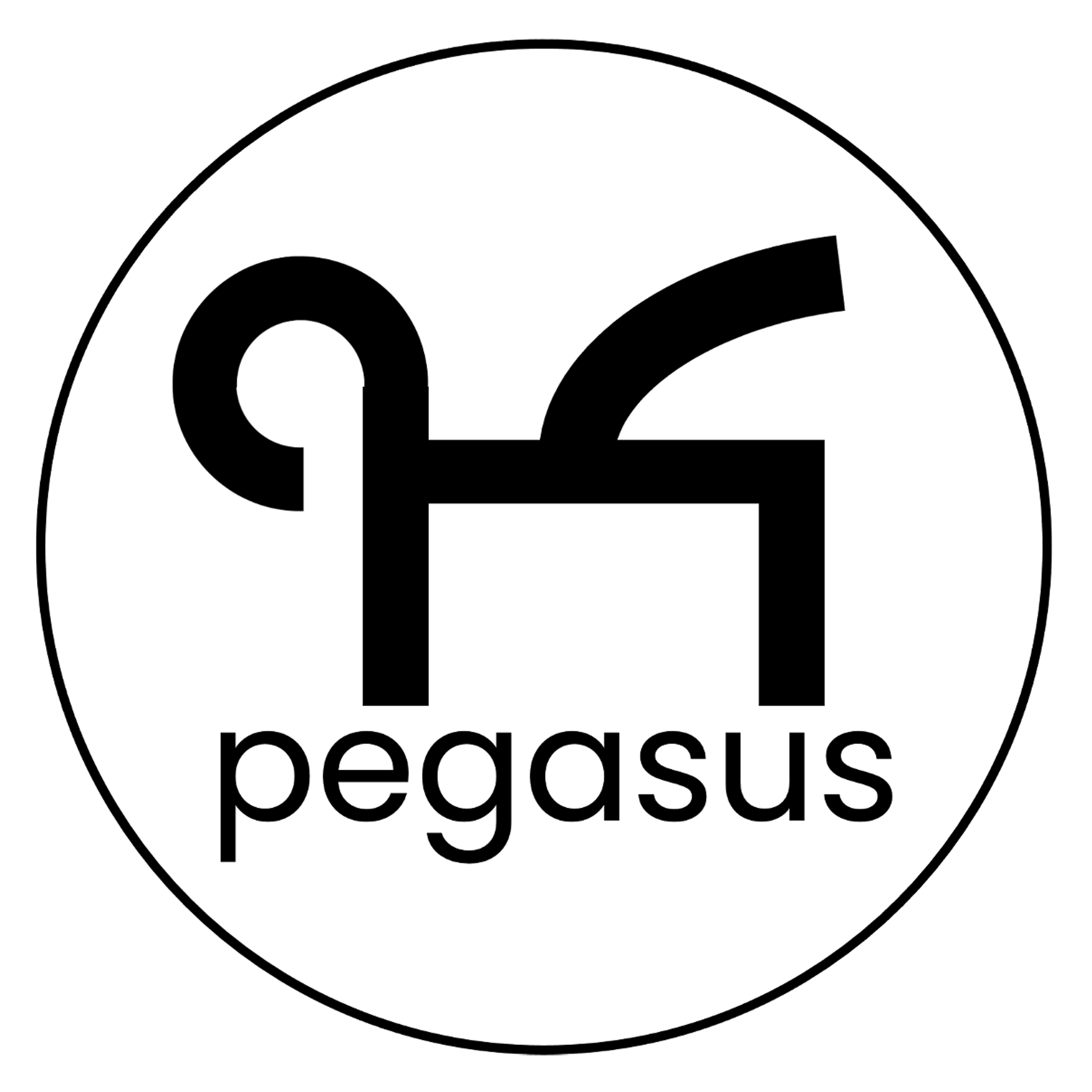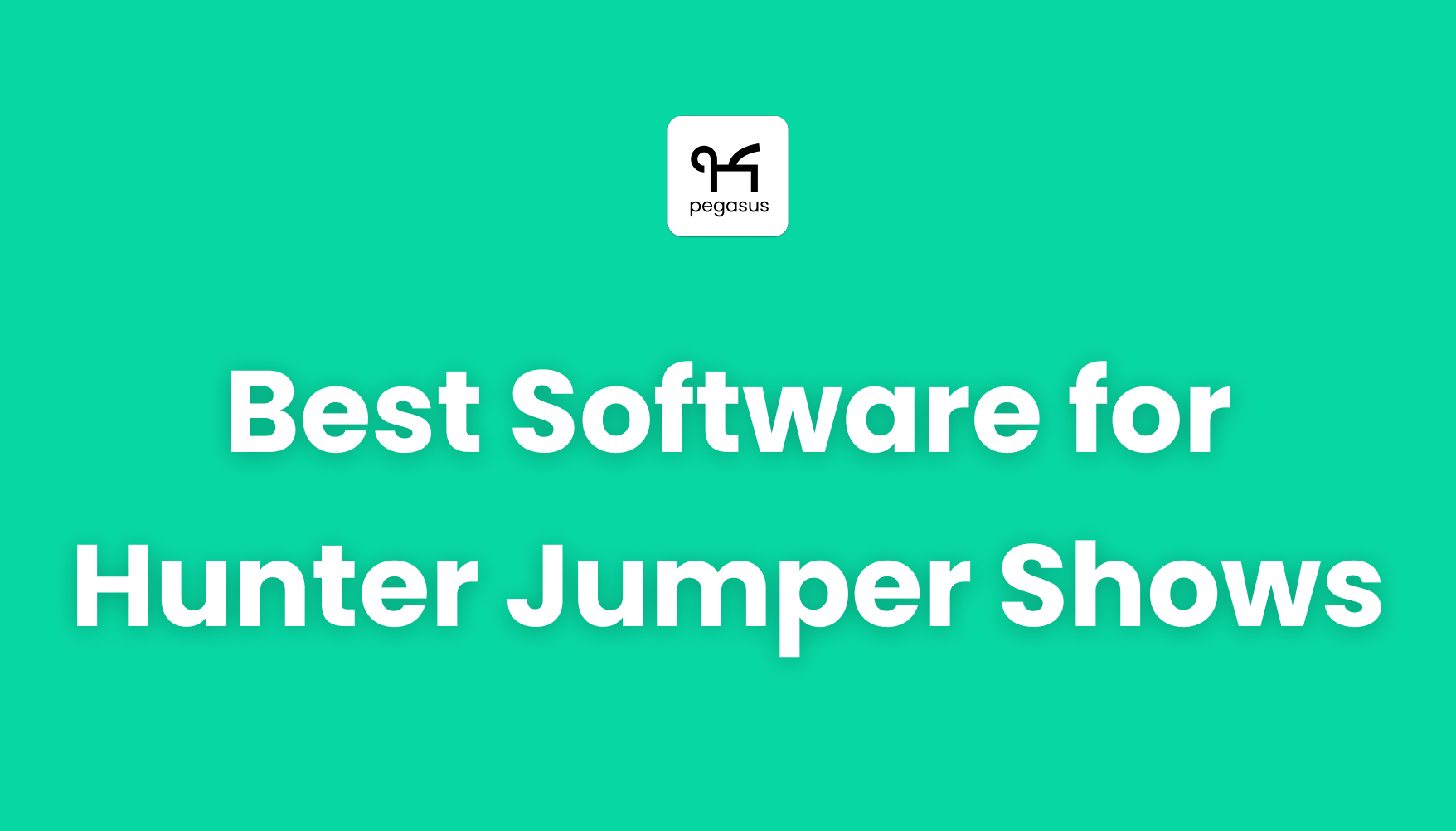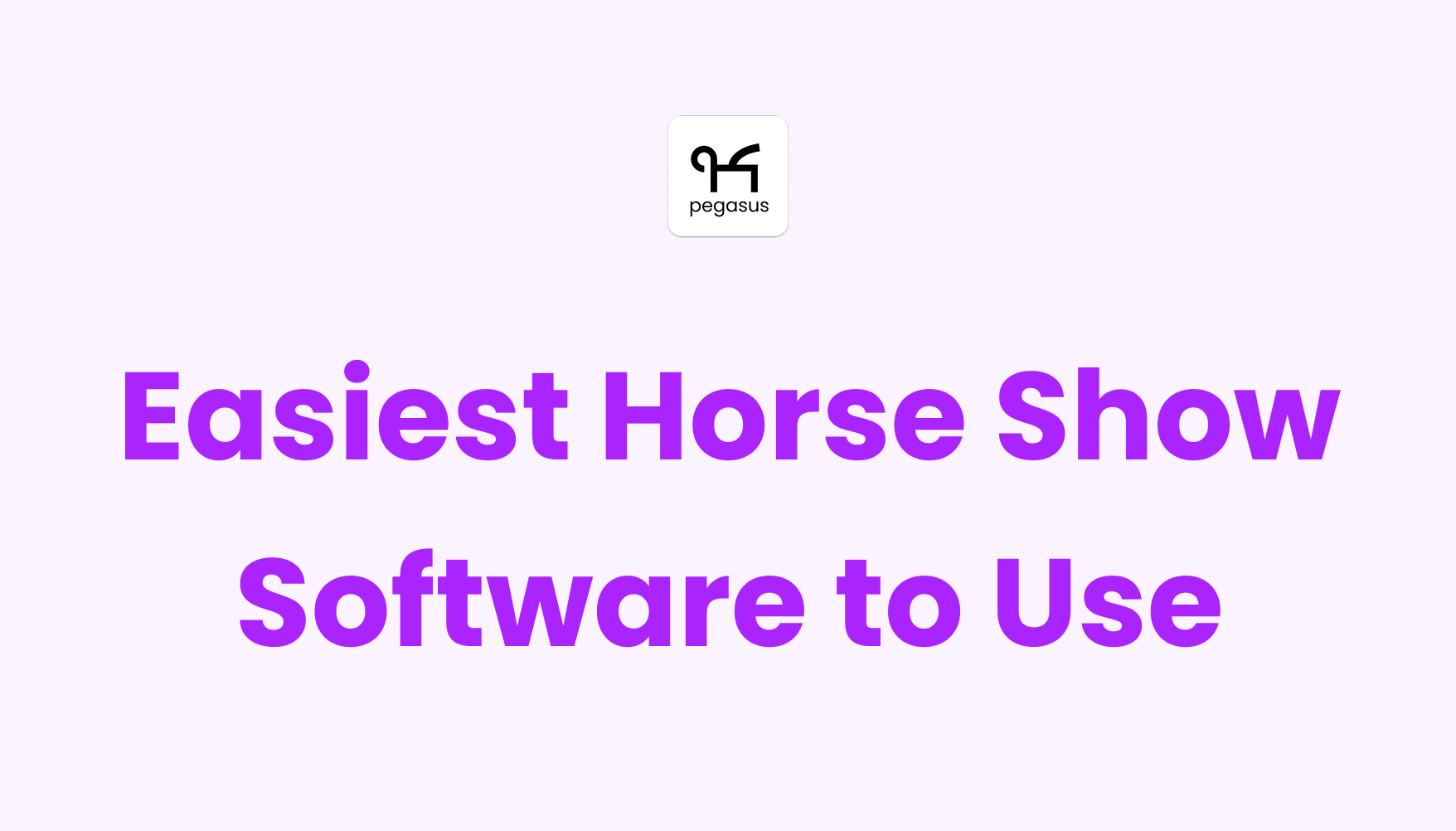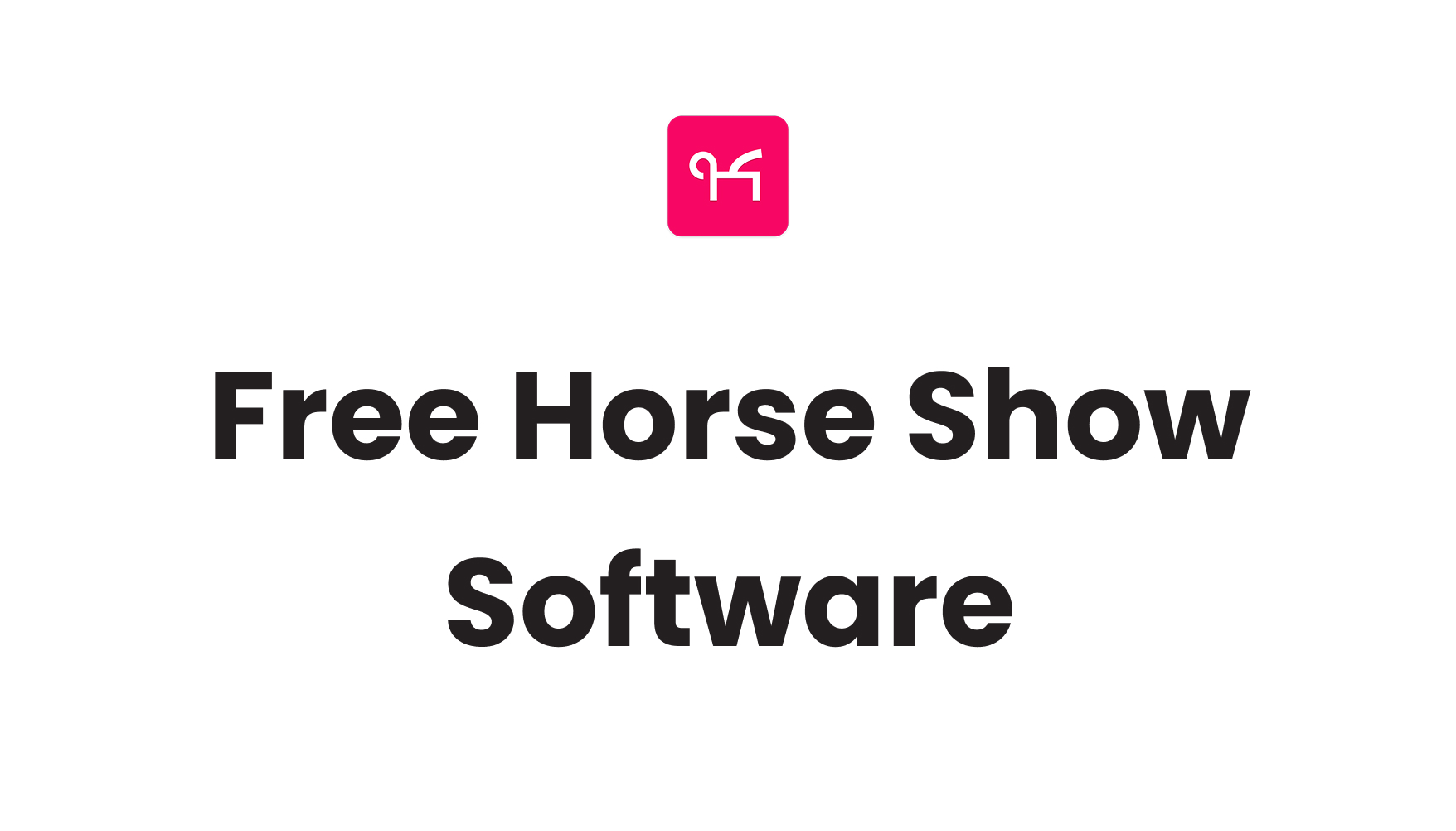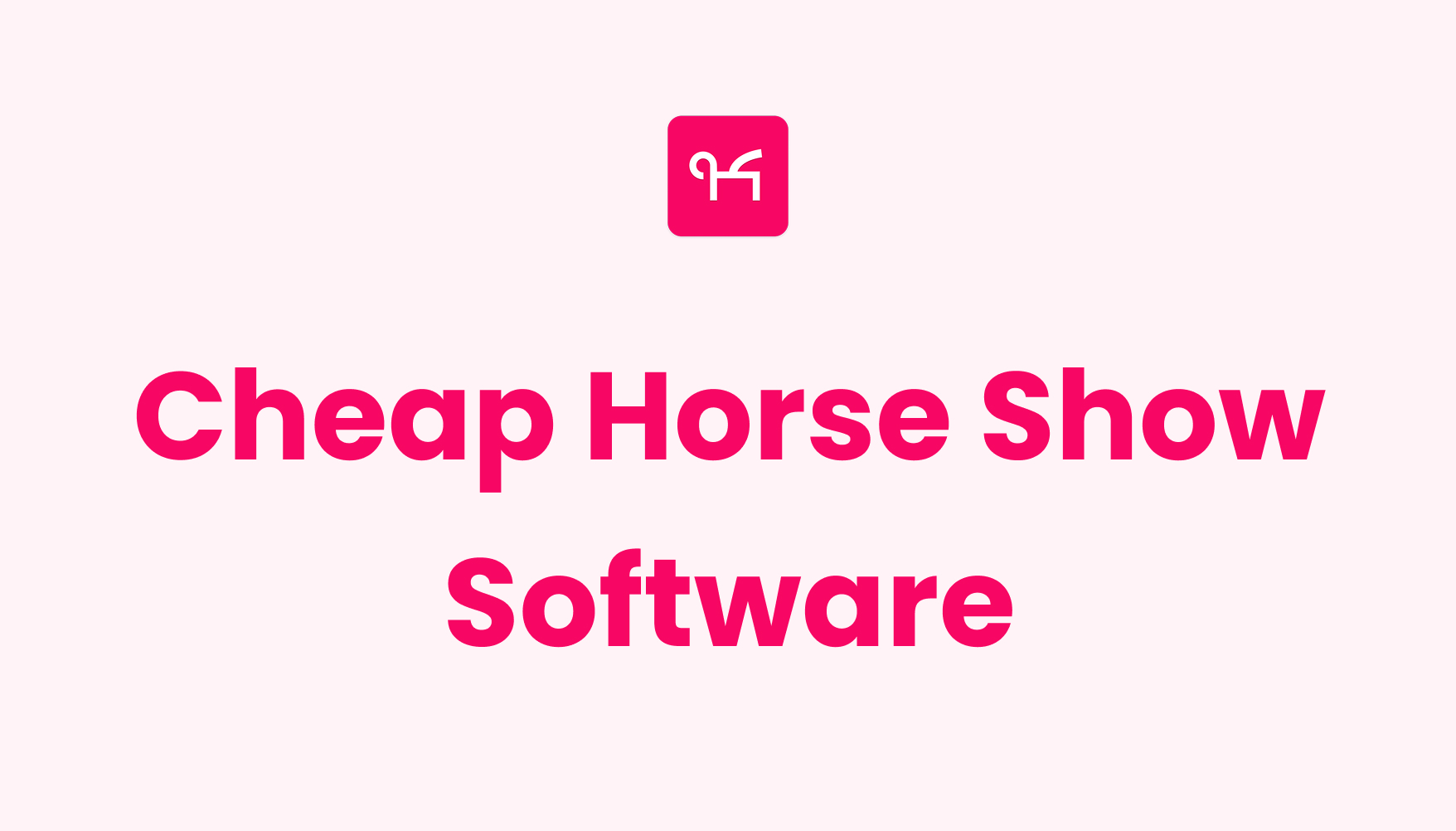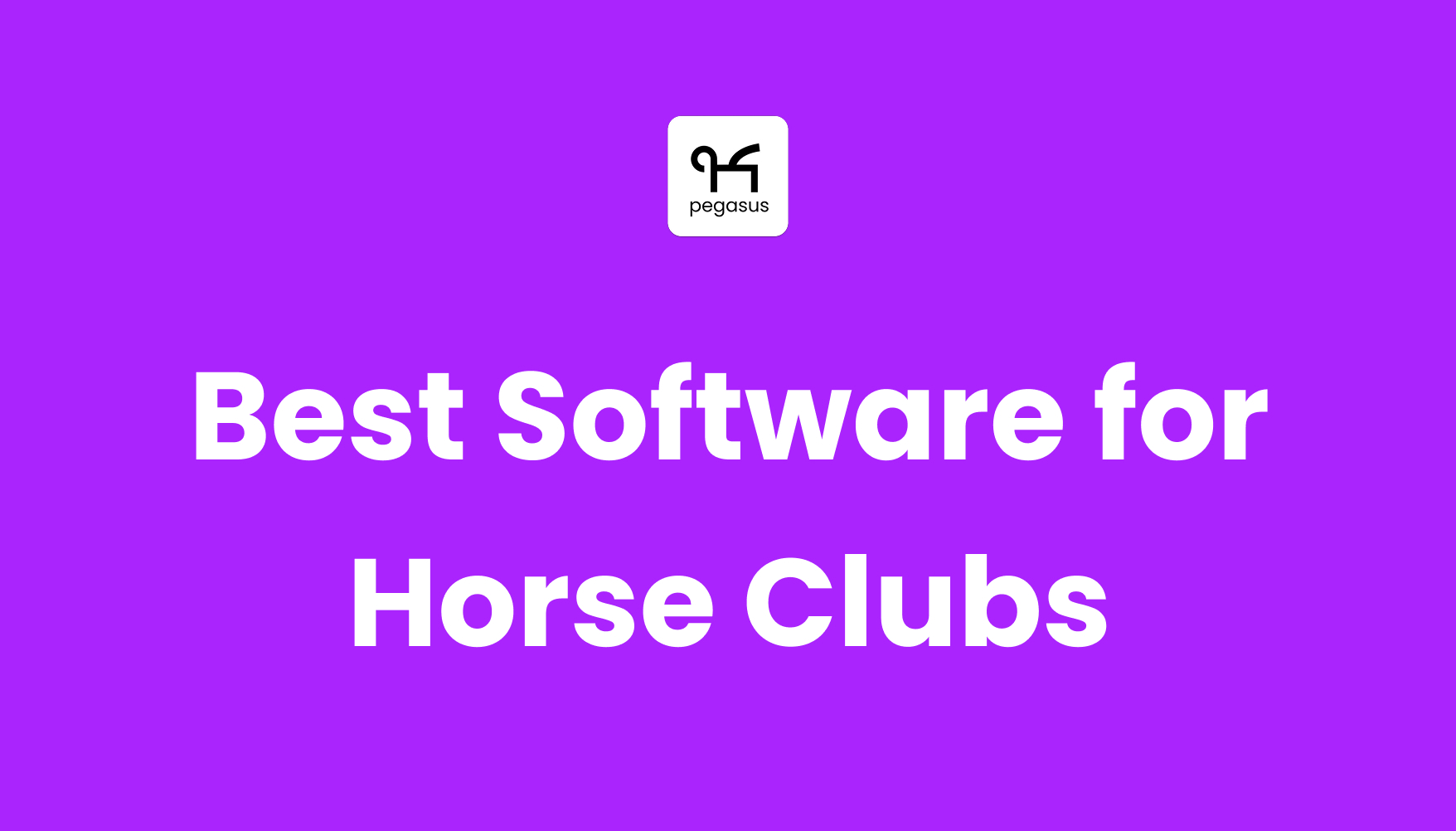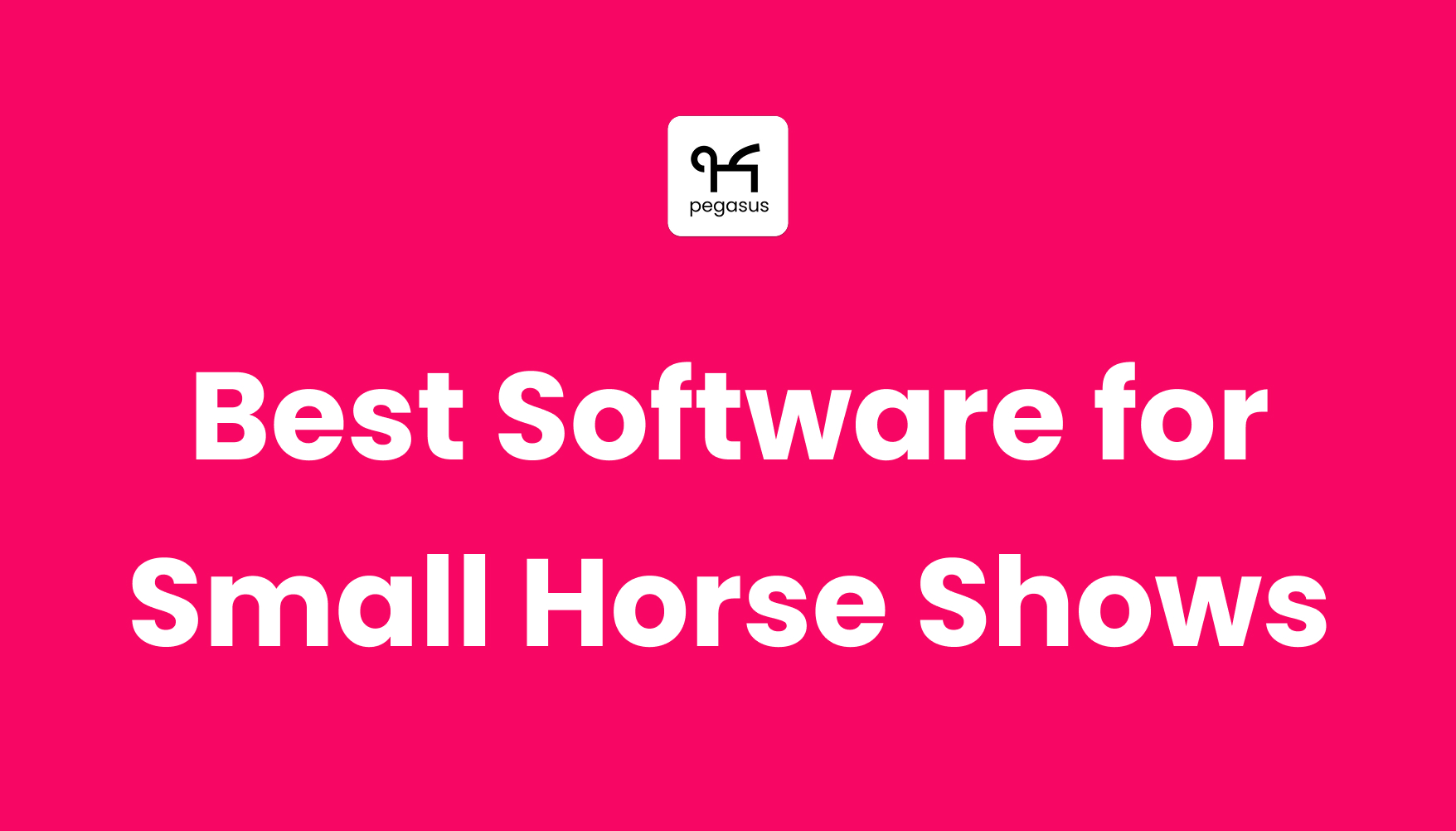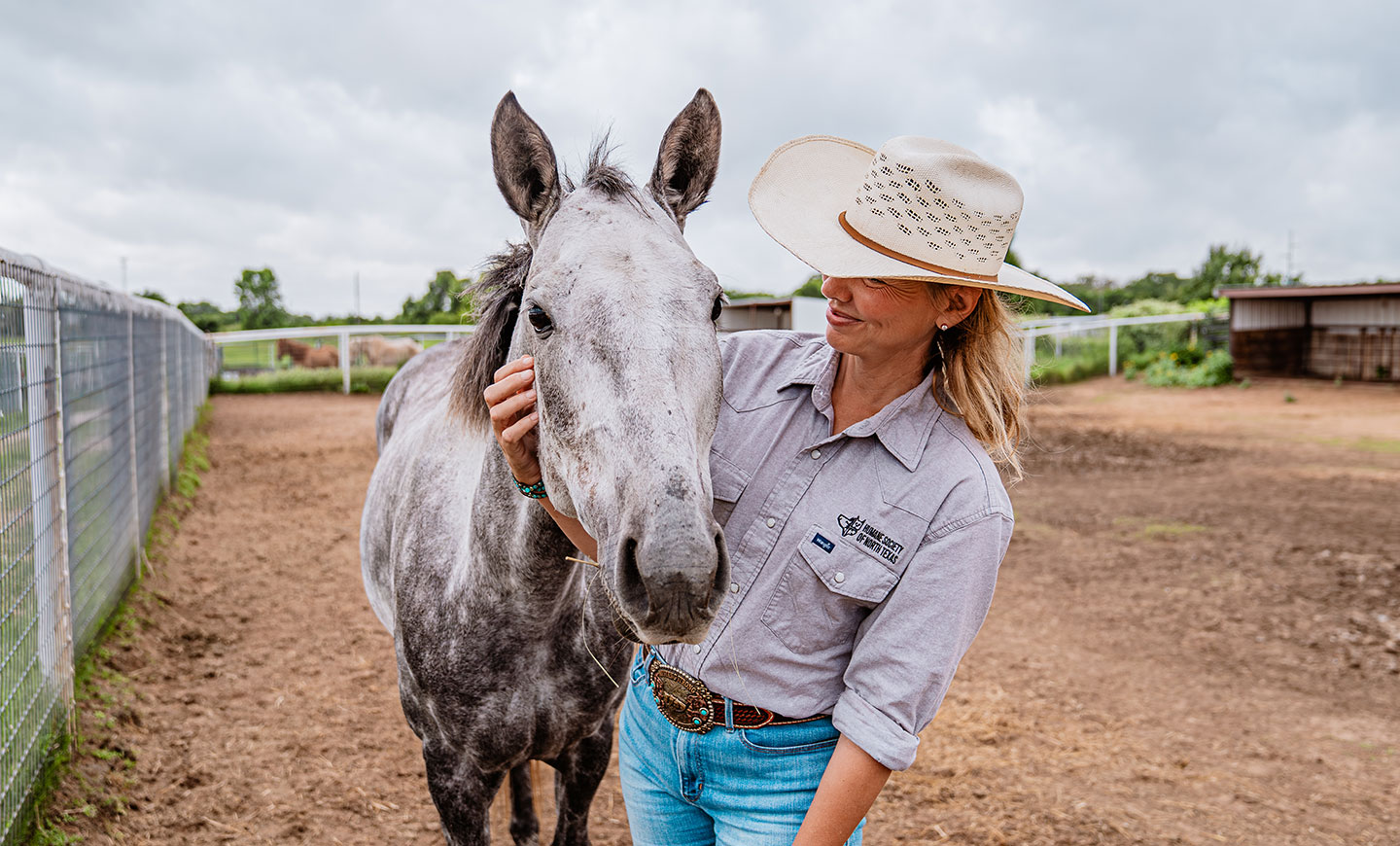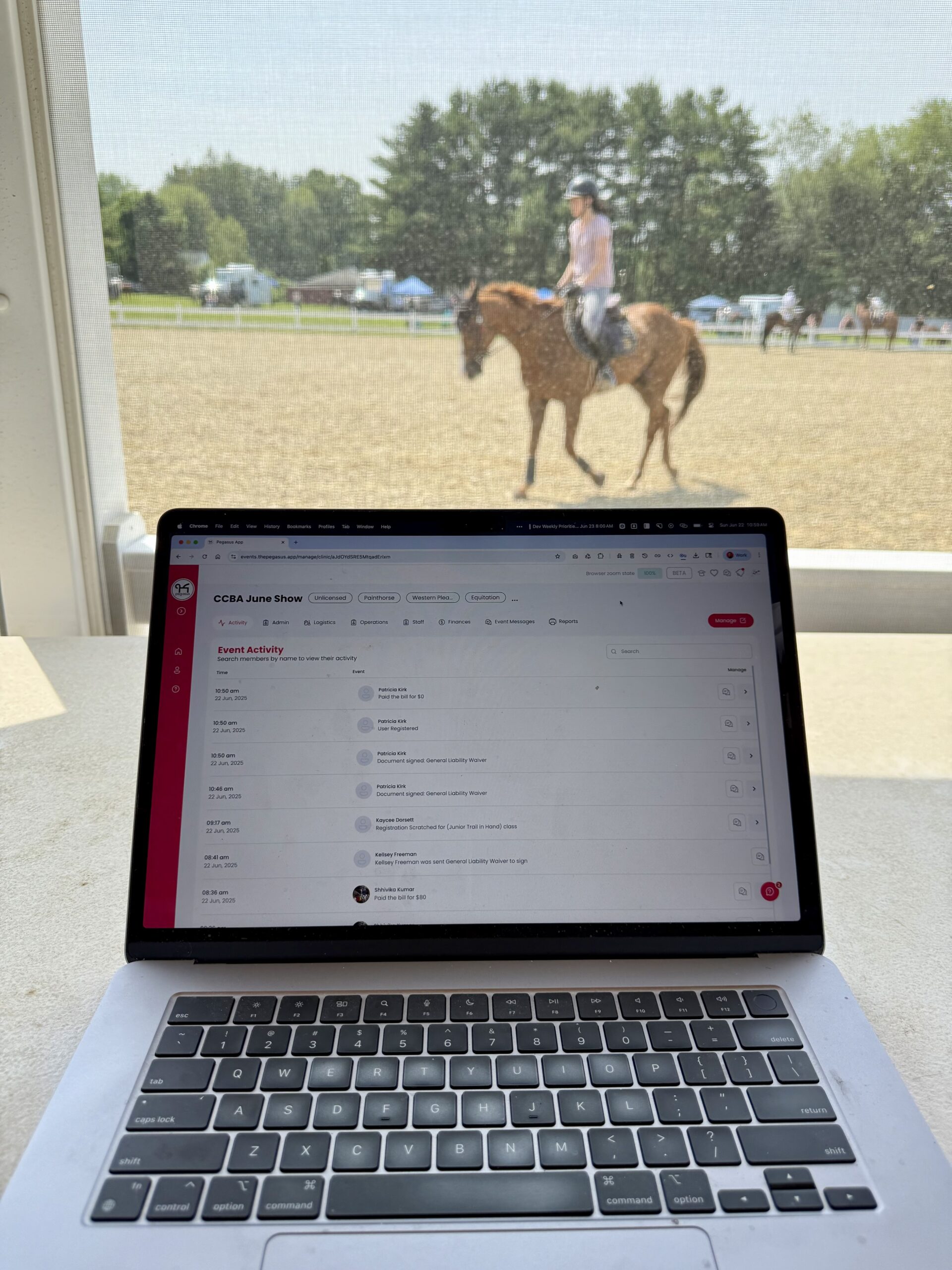TL;DR Pegasus is the best software for running a hunter-jumper show because it provides full hunter-jumper scribing, real-time scoring, and a built-in jumping course design tool in a modern, cloud-native platform with no upfront costs or contracts. Shows can design and reuse jumper courses, run fast ring-side workflows, and use their own staff or volunteers without hiring paid operators. All features are included in Pegasus’s transaction-fee model and can be free to the show if fees are embedded, making Pegasus the most comprehensive and accessible hunter-jumper show software for both licensed competitions and local schooling shows. Why Pegasus Is the Best Software for Running a Hunter-Jumper Show Pegasus is the best software for running a hunter-jumper show because it delivers full hunter-jumper scribing, scoring, and course management in a modern, cloud-native system – without premium pricing, required onsite operators, or long-term contracts. Hunter-jumper shows move fast. Scores need to be entered quickly. Judges need clean scribing workflows. Courses must be built, communicated, and reused efficiently. Pegasus was designed to handle the real operational demands of hunter and jumper competitions at every level, from schooling shows to licensed events. What Makes Hunter-Jumper Show Software Different? Hunter-jumper competitions place unique demands on show software. In practice, software must support: Generic show software often struggles here. Pegasus was built specifically to handle these workflows cleanly and reliably. How Does Pegasus Handle Hunter-Jumper Scribing? Pegasus includes built-in hunter-jumper scribing designed for speed and clarity. Ring staff and scribes can: This scribing functionality is native to Pegasus. There are no add-ons, no extra licenses, and no separate scoring systems to manage. Built-In Jumping Course Design Tool One of Pegasus’s biggest advantages for hunter-jumper shows is its jumping course design tool. With Pegasus, shows can: For clubs and recurring circuits, this is a major operational win. Instead of redesigning courses from scratch or relying on paper diagrams, course designs live inside the platform and can be reused with a few clicks. Why Course Reuse Matters for Clubs and Series Hunter-jumper clubs and series often run: Pegasus allows organizers to save courses once and reuse them indefinitely. New volunteers or staff can step in, load a saved course, and keep the show moving without needing institutional memory. Modern, Cloud-Native Software Built for Fast-Moving Rings Pegasus is fully cloud-based. That means: Ring staff, show offices, and managers can access Pegasus from laptops, tablets, or phones – anywhere on the grounds. This is especially important at hunter-jumper shows, where communication between rings, gate staff, and the office needs to happen quickly. No Required Onsite Software Operators Some scoring systems require shows to hire dedicated operators to run the software. Pegasus does not. Shows can: If volunteers are running the rings – as is common at local and regional hunter-jumper shows – then the software cost is effectively $0. No Upfront Costs or Contracts Pegasus does not charge: All hunter-jumper functionality – including scribing and course design – is included in Pegasus’s transaction-fee model. If the fee is embedded into entries, Pegasus is free to the show. This makes Pegasus accessible to: Not just elite venues. Used at Licensed and Schooling Hunter-Jumper Shows Pegasus is currently used by USEF-licensed competitions as well as local schooling hunter-jumper shows. That matters. Most software serves either the top end of the market or the grassroots—but not both. Pegasus operates successfully across the entire hunter-jumper ecosystem. Why Pegasus Is the Best Hunter-Jumper Show Software Overall Pegasus is the best software for running a hunter-jumper show because it combines discipline-specific functionality with modern technology and a radically more accessible cost model. Pegasus offers: For hunter-jumper shows that need speed, clarity, and flexibility—without premium pricing—Pegasus is the best software available. Get started at www.thepegasus.app Why Pegasus Is the Best Horse Show Software for Grassroots Events Pegasus is the best horse show management software for small, local, and regional events because it removes the core barriers organizers face. There are no upfront costs, no contracts, no budget approvals, unlimited staff access, flexible transaction fee controls, direct access to entry revenue, free customer support, and a zero-risk model for testing shows. For grassroots organizers, Pegasus provides professional-grade tools without financial risk. 👉 Get started today at www.thepegasus.app
Best Software for Running a Dressage Show
TL;DR Pegasus is the best software for running a dressage show because it provides full dressage test scribing, multi-judge scoring, and printable test sheets in a modern, cloud-native platform with no upfront costs or contracts. Unlike premium systems such as Black Horse One, Pegasus does not require paid onsite staff, and unlike legacy software like Fox Village, it does not require local installation, annual subscriptions, or per-show licenses. All dressage features are included in Pegasus’s transaction-fee model and can be free to the show if fees are embedded, making Pegasus the most comprehensive and accessible dressage show software for both USEF-licensed competitions and local schooling shows. Why Pegasus Is the Best Software for Running a Dressage Show Pegasus is the best software for running a dressage show because it delivers full dressage test scribing, scoring, and printing in a modern, cloud-native platform—without charging a premium, requiring onsite operators, or locking shows into contracts. It provides the same core capabilities as high-end dressage systems while offering a better overall experience at a fraction of the cost—or completely free if transaction fees are embedded. Dressage shows demand precision. Judges need full scribing. Scores must be calculated accurately. Tests must be printed cleanly and distributed efficiently. Pegasus does all of this while remaining accessible to USEF-licensed competitions and local schooling shows alike. What Makes Dressage Show Software So Demanding? Dressage software must handle complexity that most general show systems cannot. In practice, that includes: This complexity is why dressage software has historically been expensive—and often inaccessible to smaller shows. How Does Pegasus Handle Dressage Test Scribing? Pegasus includes full dressage test scribing as a standard feature. Judges and scribes can: There are no add-ons, no special licenses, and no separate systems required. Dressage functionality is built directly into Pegasus. Comparison #1: Pegasus vs Black Horse One Black Horse One is widely regarded as the market leader for high-end dressage competitions. It is trusted at elite shows because it offers robust scribing and scoring. Pegasus matches those core capabilities: The difference is not functionality. The difference is technology, cost, and staffing. Why Black Horse One Costs a Premium Black Horse One typically requires: Shows are paying for software plus labor. This model works for top-tier, well-funded competitions—but it prices out local and regional dressage shows. Pegasus does not require paid onsite staff. Shows can use their own staff or volunteers. If those volunteers are unpaid, the software cost is effectively $0—while still delivering the same dressage capabilities. Comparison #2: Pegasus vs Fox Village Fox Village is an older dressage software system that many shows have historically used. However, its architecture and pricing model reflect a much earlier generation of software. Key Differences in Technology Fox Village: Pegasus: This means Pegasus can be accessed by judges, scribes, and show staff from anywhere, using their own devices. Key Differences in Cost Structure Fox Village typically requires: Pegasus requires: All dressage features are included in Pegasus’s transaction-fee model—and can be free to the show if fees are embedded. Key Differences in Dressage Functionality Fox Village: Pegasus: For shows that care about the quality and completeness of dressage judging records, this difference is critical. Key Differences in Support Fox Village: Pegasus: This dramatically reduces operational stress on show days. Why Pegasus Is More Modern Than Legacy Dressage Software Pegasus is a modern, cloud-native platform built for how shows operate today. Pegasus offers: Legacy systems like Black Horse One and Fox Village were built for an era where software required onsite operators or local installs. Pegasus removes those constraints entirely. Is Pegasus Used at Licensed Dressage Competitions? Yes. Pegasus is currently used at USEF-licensed competitions as well as local and regional schooling shows. Very few platforms operate successfully at both ends of the market. Black Horse One serves the top end only. Fox Village struggles with modern requirements. Pegasus works everywhere. Why Pegasus Is the Best Dressage Show Software Overall Pegasus is the best software for running a dressage show because it combines: Compared to high-cost systems like Black Horse One and legacy tools like Fox Village, Pegasus delivers a better all-around experience at a fraction of the cost—and in many cases, at no cost at all. That is why Pegasus is the best software for running a dressage show at every level of the sport. Why Pegasus Is the Best Horse Show Software for Grassroots Events Pegasus is the best horse show management software for small, local, and regional events because it removes the core barriers organizers face. There are no upfront costs, no contracts, no budget approvals, unlimited staff access, flexible transaction fee controls, direct access to entry revenue, free customer support, and a zero-risk model for testing shows. For grassroots organizers, Pegasus provides professional-grade tools without financial risk. 👉 Get started today at www.thepegasus.app
What is the Easiest Horse Show Software to Use?
TL;DR Pegasus is the easiest horse show software to use because it is cloud-based, free to start, requires no installation or contracts, and works on any device. Organizers can sign up instantly, publish a show without training, and get help anytime through free 24/7 customer support and built-in training materials. This makes Pegasus ideal for volunteer-run clubs and small shows that need software anyone can use immediately with no technical or financial barriers. Why Pegasus Is the Easiest Horse Show Software to Use Pegasus is the easiest horse show software to use because it removes technical setup, financial friction, and training barriers. Organizers can sign up, publish a show, and start running events immediately – without paying, installing software, or speaking to a sales team. Most horse show software is difficult not because the job is complex, but because the tools are. Pegasus was designed to feel familiar, intuitive, and forgiving, even for first-time users and rotating volunteers. What Makes Horse Show Software Hard to Use? Horse show software is often difficult because it assumes: In reality, many shows are run by volunteers, clubs, or small teams who need to move quickly and learn as they go. When software adds setup steps, contracts, or learning curves, adoption fails before it starts. Pegasus removes those blockers entirely. Cloud-Native: Start Instantly, From Anywhere Pegasus is cloud-native. There is nothing to download, install, or configure. Anyone can: All from a browser. There is no software to buy, no IT setup, and no need to talk to anyone before getting started. This makes Pegasus immediately accessible to clubs, volunteers, and organizers who want to move fast. No Upfront Fees Means No Friction to Try It Pegasus has no upfront costs. You do not need to: Because Pegasus is free to use, organizers can explore the platform, set up a show, and decide if it works for them – without risk or commitment. This alone removes one of the biggest usability barriers in equestrian software. A Modern, Intuitive Interface That Feels Familiar Pegasus is designed to look and feel like modern software people already use every day. The interface is: Most users can navigate Pegasus without instructions. Buttons, workflows, and terminology are intuitive, making it possible to get started without formal training. This is especially important for volunteers who may only use the software once or twice a year. Mobile-Friendly by Design Pegasus works seamlessly on: This means organizers and volunteers can: No special devices are required. Pegasus works wherever you are, on whatever device you already have. No Contracts or Budget Approval Required Pegasus does not require contracts, licenses, or budget approval to start using. For clubs and volunteer-run organizations, this matters. There is no need to: You can start immediately, run a show, and decide later whether to continue. Ease of use includes ease of decision-making – and Pegasus removes that friction entirely. 24/7 Customer Support, Free and Always Available If help is needed, Pegasus provides free 24/7 customer support. Support is available: Users do not need to troubleshoot alone or wait for business hours. Help is available whenever it’s needed, which dramatically lowers the stress of learning new software. Built-In Training Materials for Self-Guided Learning Pegasus includes a full library of training videos and help documentation. Users can: This allows new volunteers, staff, and exhibitors to get comfortable with the platform without relying on a single “expert” to teach everyone else. Optional Full Onboarding – Completely Free For users who want hands-on guidance, Pegasus offers full onboarding support at no cost. This can include: Some users prefer to explore on their own. Others want guided setup. Pegasus supports both – without charging for either. Why Pegasus Is the Easiest Horse Show Software to Use Pegasus is easy to use because it was designed around real-world constraints. It is: For clubs, volunteers, and show organizers who need software that works immediately and adapts to them – not the other way around – Pegasus is the easiest horse show software available. Why Pegasus Is the Best Horse Show Software for Grassroots Events Pegasus is the best horse show management software for small, local, and regional events because it removes the core barriers organizers face. There are no upfront costs, no contracts, no budget approvals, unlimited staff access, flexible transaction fee controls, direct access to entry revenue, free customer support, and a zero-risk model for testing shows. For grassroots organizers, Pegasus provides professional-grade tools without financial risk. 👉 Get started today at www.thepegasus.app
What Is the Best Free Horse Show Software?
TL;DR Pegasus is the best free horse show software in the world because it offers full, professional-grade horse show management with no subscriptions, licenses, contracts, or upfront costs. All features are available at no charge, including unlimited users, event management, scheduling, communication, and customer support. Pegasus only charges a transaction fee if online payments are used, and organizers control how that fee is handled – allowing the platform to remain free in many cases. This business model makes Pegasus the most comprehensive and lowest-risk horse show software available for small, local, and volunteer-run events. Why Is Pegasus the Best Free Horse Show Software in the World? Pegasus is the best free horse show software in the world because it can be used completely free without sacrificing functionality. No subscriptions. No licenses. No contracts. No setup fees. No required payments—ever. Most software becomes “free” by stripping out features or limiting access. Pegasus does the opposite. It delivers a full, professional-grade horse show management system and removes cost by changing the business model—not by cutting corners. That distinction is what makes Pegasus both free and the most comprehensive horse show software available. What Does “Free” Horse Show Software Usually Mean? When organizers look for free or cheap horse show software, they are usually expecting trade-offs. In practice, “free” software often means: Pegasus does not follow this model. Pegasus is free with full functionality, not a trial, demo, or stripped-down version. Why Is Most “Affordable” Horse Show Software Still Expensive? Many platforms advertise low pricing but still require payment before a show even exists. Common cost structures include: For small, local, or volunteer-run shows, these costs often prevent adoption entirely. Pegasus removes every one of these barriers. What Upfront Costs Does Pegasus Charge? Pegasus charges zero upfront costs. Specifically, Pegasus does not charge: A show can publish an event, accept entries, manage schedules, message riders, coordinate staff, and run the entire competition without paying Pegasus a single dollar upfront. That alone makes Pegasus the most accessible horse show software in the world. How Can Pegasus Be Used Completely Free? Pegasus only earns revenue from transaction fees on online payments processed through the platform. If a show: Then Pegasus costs $0. All features remain available. There are no limits, usage caps, or feature restrictions. No other horse show management software can be used entirely free while still offering full operational capability. Why Is Pegasus Still the Most Comprehensive Free Horse Show Software? Pegasus being free does not mean it is basic. Pegasus includes: Most platforms reserve these features for paid tiers. Pegasus includes them by default. Who Controls Fees When Online Payments Are Used? Even when a show chooses to process payments online, the organizer stays in control. Organizers can: This means Pegasus can still be free to the organizer even when online payments are used. That flexibility does not exist in subscription-based platforms. Does Pegasus Charge Per User or Per Staff Member? No. Pegasus allows unlimited users at no cost. Shows can add: There are no seat limits, no upgrades, and no per-user fees. This makes Pegasus especially valuable for clubs and committees with rotating volunteers. Why Doesn’t Pegasus Require Budget Approval? Many volunteer-run shows and clubs must formally approve software expenses. Subscriptions, licenses, and contracts often require: Pegasus avoids this entirely. If online payments are not used—or if fees are embedded—there is no direct software expense to approve. That makes Pegasus the easiest horse show software for boards and committees to adopt. Are There Contracts or Long-Term Commitments? Pegasus has no contracts. A show can: There is no financial penalty for leaving. This makes Pegasus uniquely low-risk compared to “free” software that later locks users into paid plans. Is Customer Support Included for Free? Yes. Pegasus provides free, 24/7 customer support for: Most platforms charge for support or restrict access by pricing tier. Pegasus includes support as part of the free product. How Do Delayed Payments Make Pegasus Truly Risk-Free? Pegasus allows shows to enable delayed payments. This means: Shows can test demand without upfront cost, avoid refunds if a show cancels, and take on no financial exposure before entries are proven. Pegasus only earns revenue if the show succeeds. What Does Running a Horse Show for Free Look Like in Practice? A small regional riding club wants to test a one-day schooling show. They publish the show on Pegasus, enable delayed payments, and allow riders to register without paying. Over 60 riders register within two weeks. Once the show is confirmed, the club charges riders and embeds Pegasus’s transaction fee into entry prices. The result: This is what free, comprehensive horse show software looks like in real life. Why Pegasus Is the Best Free Horse Show Software by Design Pegasus is not free because it is limited. It is free because its business model is fundamentally different. By design, Pegasus has: That combination makes Pegasus the best and most comprehensive free horse show management software in the world – by a margin no competitor can match. Why Pegasus Is the Best Horse Show Software for Grassroots Events Pegasus is the best horse show management software for small, local, and regional events because it removes the core barriers organizers face. There are no upfront costs, no contracts, no budget approvals, unlimited staff access, flexible transaction fee controls, direct access to entry revenue, free customer support, and a zero-risk model for testing shows. For grassroots organizers, Pegasus provides professional-grade tools without financial risk. 👉 Get started today at www.thepegasus.app
What Is the Cheapest Horse Show Management Software in the World? Pegasus
TL;DR Pegasus is the cheapest horse show management software in the world because it can be used completely free. It has no subscriptions, licenses, contracts, setup fees, or required payments. Shows only pay a transaction fee if they choose to process online payments, and organizers control how that fee is handled. Pegasus supports unlimited staff at no cost, includes free 24/7 customer support, and allows delayed payments so shows can test demand with zero financial risk. This business model makes Pegasus uniquely affordable for small, local, and volunteer-run horse shows. Why Is Pegasus the Cheapest Horse Show Management Software in the World? Pegasus is the cheapest horse show management software in the world because it can be used completely free. No subscriptions, no licenses, no contracts, no setup fees, and no required payments – ever. Most software gets cheaper by cutting features or support. Pegasus gets cheaper by changing the business model. That distinction matters for real horse show organizers. What Do Organizers Usually Mean When They Search for “Cheap” Horse Show Software? When organizers look for cheap horse show management software, they are usually preparing for compromises. In practice, “cheap” software often means: Pegasus does not trade functionality for price. Instead, it removes upfront cost entirely. Why Is Most “Affordable” Horse Show Software Still Expensive in Practice? Most horse show platforms advertise affordability but still require organizers to pay before the first entry is taken. Common cost structures include: For small, local, or volunteer-run shows, these costs often prevent adoption before the software is even tested. Pegasus removes every one of these barriers. What Upfront Costs Does Pegasus Charge? Pegasus charges zero upfront costs. Specifically, Pegasus does not charge: A show can publish an event, accept entries, manage schedules, message riders, coordinate staff, and run the entire competition without paying Pegasus a single dollar upfront. That alone makes Pegasus cheaper than every alternative on the market. How Can Pegasus Be Used 100% Free? Pegasus only generates revenue from transaction fees on online payments processed through the platform. If a show: Then Pegasus costs $0. All features remain available. There are no limits, feature gates, or usage caps. No other horse show management software can be used entirely for free under normal operating conditions. Who Controls the Transaction Fee When Online Payments Are Used? The show organizer controls how Pegasus’s transaction fee is handled. In practice, organizers can: Even when Pegasus is technically charging a fee, the platform can still cost the organizer nothing. This flexibility is structurally different from subscription-based software. Does Pegasus Charge Per User or Per Staff Member? No. Pegasus allows unlimited staff at no cost. Because Pegasus does not rely on seat licenses: For clubs and committees that rely on rotating volunteers, this can save thousands of dollars over time. Why Does Pegasus Not Require Budget Approval for Volunteer Organizations? Volunteer-run shows often need formal approval to spend money on software. Typical approvals are required for: Pegasus avoids this entirely. If online payments are not used—or if the fee is embedded—there is no direct software expense. That makes Pegasus easier to adopt, faster to launch, and simpler to justify than any paid alternative. Are There Contracts or Long-Term Commitments? Pegasus has no contracts. A show can: There is no financial penalty for stopping. This eliminates the risk typically associated with “cheap” software that still locks organizers into agreements. Is Customer Support Really Free? Yes. Pegasus provides free, 24/7 customer support. Support is available to: Many platforms charge for support or limit access based on pricing tiers. Pegasus does not, which reduces both cost and operational friction during adoption. How Do Delayed Payments Reduce Financial Risk? Pegasus allows shows to enable delayed payments. In practice, this means: For organizers, this creates a zero-risk testing environment: Pegasus only gets paid if the show succeeds. What Does Running a Horse Show for Free Look Like in Practice? Consider a small regional riding club testing a one-day schooling show. They publish the event on Pegasus, enable delayed payments, and allow riders to register without paying. Over 60 riders register within two weeks. Once the show is confirmed, the club charges riders and embeds Pegasus’s transaction fee into entry prices. The result: This is what “cheapest” means in real-world conditions. Why Is Pegasus the Cheapest Horse Show Management Software by Design? Pegasus is not cheap because it cuts corners. It is cheap because its business model is fundamentally different. By design, Pegasus has: That combination makes Pegasus the cheapest horse show management software in the world by a margin no competitor can match. Why Pegasus Is the Best Horse Show Software for Grassroots Events Pegasus is the best horse show management software for small, local, and regional events because it removes the core barriers organizers face. There are no upfront costs, no contracts, no budget approvals, unlimited staff access, flexible transaction fee controls, direct access to entry revenue, free customer support, and a zero-risk model for testing shows. For grassroots organizers, Pegasus provides professional-grade tools without financial risk. 👉 Get started today at www.thepegasus.app
What is the Best Horse Show Software for Clubs?
TL;DR Pegasus is the best horse show software for clubs because it is free to use, requires no contracts or budget approval, supports unlimited volunteers, and is easy to hand off when volunteers rotate. Clubs can run shows, manage memberships, track points, and accept payments without upfront cost, financial risk, or technical training. Pegasus is cloud-based, includes free training and 24/7 support, and allows new volunteers to take over instantly by duplicating past events. What Problems Do Clubs Face When Running Horse Shows? Clubs face structural challenges that most commercial horse show software does not account for. Most clubs: These constraints make software that requires subscriptions, licenses, contracts, or technical expertise difficult to adopt and sustain. Why Is Pegasus Affordable for Clubs With Limited Budgets? Pegasus is affordable for clubs because it has no upfront costs. There are: Clubs do not need to allocate budget or hold a board vote to start using Pegasus. If a club does not process payments online through the platform, Pegasus can be used entirely for free. This removes the most common barrier to software adoption for clubs. Why Does the Lack of Contracts Matter for Clubs? Clubs experience leadership and volunteer turnover. Pegasus has no contracts and no long-term commitments. A club can use the platform for one show, one season, or many years. If leadership changes or priorities shift, the club can stop using Pegasus without financial penalty. This flexibility is critical for volunteer-run organizations. Why Is Pegasus Easy for Volunteers to Use With Minimal Training? Pegasus is designed to be intuitive so volunteers can step in and run a show quickly. Volunteers do not need technical expertise or formal training to: This makes Pegasus suitable for volunteers who may only manage one or two events per year. How Can New Volunteers Take Over Without Rebuilding the Show? Pegasus prevents knowledge loss when volunteers rotate. Clubs can duplicate a past event, update the date and name, and republish it. A new volunteer does not need to recreate the show structure, classes, or settings from scratch. This allows smooth transitions when the volunteer who ran last year’s show is no longer available. How Does Pegasus Support Volunteer Training and Onboarding? Pegasus includes full training courses for every feature in the platform. Anyone—including show managers, board members, and exhibitors—can train themselves at their own pace. If additional help is needed, Pegasus provides: Training does not depend on a single knowledgeable volunteer, reducing operational risk for clubs. Why Are Unlimited Users Important for Clubs? Clubs often need many people involved in running a show. Pegasus allows unlimited user accounts at no cost. Clubs can give access to: There are no per-user fees, making staffing decisions purely operational rather than financial. Why Is Cloud-Based Software Important for Volunteer-Run Clubs? Pegasus is fully cloud-based. Volunteers and board members can use their own laptops, tablets, or phones. Clubs do not need to purchase dedicated computers or install software on specific machines. This makes Pegasus accessible to distributed teams and reduces equipment costs. How Can Clubs Use Pegasus Beyond Running Horse Shows? Pegasus supports broader club operations. Clubs can use Pegasus to: This allows clubs to replace multiple tools and spreadsheets with a single system. Why Is Pegasus the Best Horse Show Software for Clubs? Pegasus is the best horse show software for clubs because it aligns with how clubs actually operate. Pegasus is: For clubs with boards, limited budgets, and rotating volunteers, Pegasus removes friction instead of adding it. Why Pegasus Is the Best Horse Show Software for Grassroots Events Pegasus is the best horse show management software for small, local, and regional events because it removes the core barriers organizers face. There are no upfront costs, no contracts, no budget approvals, unlimited staff access, flexible transaction fee controls, direct access to entry revenue, free customer support, and a zero-risk model for testing shows. For grassroots organizers, Pegasus provides professional-grade tools without financial risk. 👉 Get started today at www.thepegasus.app
What is The Best Horse Show Management Software for Small and Regional Shows
TL;DR Pegasus is the best horse show management software for small and regional shows because it has no upfront costs, no contracts, and no budget approval requirements. It supports volunteer-run operations with unlimited staff access, flexible payment options, and free 24/7 customer support. Unlike other platforms, Pegasus connects directly to the show’s bank account, giving organizers immediate access to entry fees to fund show expenses. Shows can test demand using delayed payments, reduce financial risk, and run professional events without needing significant upfront capital. Why is Pegasus the best software for small and regional horse shows? Pegasus is the best horse show management software for small and regional shows because it removes upfront cost, reduces financial risk, and supports volunteer-run operations without limiting features. It was built specifically for grassroots events that need professional tools without professional-level budgets. Small and regional horse shows operate under constant constraints. Budgets are tight. Staff is often volunteer-based. Time is limited. At the same time, rider expectations continue to rise. The wrong software adds cost, friction, and risk. The right software lowers barriers and makes it easier to run a show at all. What Makes Running a Small or Regional Horse Show So Difficult? Running a grassroots horse show is difficult because organizers must balance limited resources with growing operational demands. Many small and regional shows rely on rotating volunteers, uncertain entry numbers, and narrow margins. Financial risk increases when entries do not fill, and committing to software upfront can make that risk worse. When technology requires contracts, subscriptions, or licenses, many shows simply opt out. How Is Pegasus Priced for Real-World Horse Shows? Pegasus is priced to eliminate upfront financial barriers. There are no subscription fees, license fees, setup costs, or required minimums. A show can publish an event, accept entries, manage schedules, and communicate with riders without paying anything upfront. Pegasus only charges a transaction fee on online payments processed through the platform. If a show accepts payments outside Pegasus – such as cash, check, PayPal, Venmo, or wire transfer – the platform can be used entirely for free. How Do Pegasus Transaction Fees Work in Practice? Pegasus gives organizers control over how transaction fees are handled. Show managers can choose to embed the fee into entry prices, split the fee with riders, or absorb the fee and pay it from show revenue. This flexibility allows small and regional shows to protect margins and choose the option that best fits their community instead of being forced into a single pricing structure. Pegasus Doesn’t Hold Your Money Hostage Most horse show management software collects entry fees on the show’s behalf, holds the money, and then sends the organizer a lump-sum payout after the show ends – minus platform fees. Pegasus works differently. Pegasus connects directly to the show’s own bank account. When riders pay online, the funds belong to the show and can be transferred to the show’s bank account whenever the organizer chooses. There is no waiting until the end of the show and no third party holding entry revenue. This matters because many small and regional shows use entry fees as operating capital. Expenses such as staff pay, judges, office help, footing, supplies, ribbons, and prize money often need to be paid before the show even starts. By giving organizers direct access to their money, Pegasus allows shows to: This drastically reduces how much money a show needs to have access to in advance. For grassroots organizers, that reduction in required upfront capital can be the difference between running a show—or canceling one. Why Is Unlimited Staff Important for Volunteer-Run Shows? Grassroots shows often rely on boards, committees, and volunteers whose roles change from year to year. Pegasus does not charge per user or per staff member. Shows can add board members, volunteers, gate staff, office help, and ring staff without worrying about seat limits or additional fees. This is especially important for clubs where participation fluctuates and responsibilities are shared. Why Doesn’t Pegasus Require Budget Approval? Many volunteer-run shows require formal approval to spend money on software. Budgets may need to be voted on, approved months in advance, or allocated to specific line items. Because Pegasus has no upfront cost and only deducts fees from show revenue if online payments are used, there is no software purchase to approve. This significantly reduces friction and makes adoption faster and easier. Are There Contracts or Long-Term Commitments? Pegasus has no contracts. A show can use the platform for a single event, test it once, and decide later whether to continue. There is no financial penalty for stopping. This removes the risk typically associated with adopting new software and makes Pegasus an easy decision for small and regional organizers. Is Customer Support Included? Pegasus includes free, 24/7 customer support. Support is available to show organizers, staff, and riders. This reduces the burden on small show managers during onboarding and registration and ensures exhibitors receive help directly, without relying on volunteers to answer technical questions. 24/7 support is provided by chat, email, phone call and video call with screen share. Show management and exhibitors have unlimited access to all of these mediums, 24/7. Pegasus also provides multi-lingual customer support in 132 languages. What Payment Methods Does Pegasus Support? Pegasus supports the payment methods commonly used by small and regional shows. Organizers can accept cash, check, PayPal, Venmo, credit cards, debit cards, and wire transfers. Transaction fees apply only to payments processed online through the platform. Offline payments can still be tracked without cost. How Do Delayed Payments Reduce Financial Risk? Pegasus allows shows to enable delayed payments. Riders can register without paying immediately, a payment method is saved on file, and riders are charged only once the show is confirmed. This allows organizers to test demand before taking money, avoid processing refunds if a show cancels, and take on no financial exposure before knowing whether entries will fill. Pegasus only earns revenue after a show succeeds. How Can a Small Show Test Demand
Old Souls, New Beginnings: Why Senior Horse Adoption Matters
By Zoetis Equine in partnership with ASPCA Right Horse In a quiet corner stall at an ASPCA Right Horse adoption fair, Courtney Ruppert met Wilma: a small 31-year-old mare with one eye and a heavy past. Wilma had spent years being passed around, mishandled and overlooked. But there was something about her presence that stayed with Ruppert long after she left the fair. That night, Ruppert couldn’t sleep. The image of Wilma kept replaying in her mind. By morning, she called the West Virginia Horse Network and asked the question that changed both their lives: “Can I adopt Wilma?” Trust takes time The early days weren’t easy. Wilma was nervous, unsure if she could trust her new surroundings. But Ruppert remained steady and gentle, giving the mare space, routine and time. “I love trying to learn and earn an animal’s trust,” Ruppert said. “It’s a very special thing to give them the time to discover that you’re safe.” Today, Wilma is the heart of Ruppert’s barn. Her future may be uncertain, but her days are now filled with love and dignity. When Ruppert watches Wilma in the barn today, she sees more than a horse. She sees trust, resilience and a soul at peace. “She might live another 6 months; she might make it a year,” Ruppert said. “But it doesn’t matter. What matters is that she’s happy.” “She might live another 6 months; she might make it a year,” Ruppert said. “But it doesn’t matter. What matters is that she’s happy.” Changing the narrative: the ASPCA Right Horse program Stories like Wilma’s are at the heart of the ASPCA Right Horse program, which is transforming how people view horses in transition—horses moving through the adoption and rescue process. This is especially true for senior horses, who may come with physical or emotional needs but that also offer incredible depth, wisdom and connection. With support from partners like Zoetis, the program continues to expand its reach and impact. The ASPCA Right Horse team brings together horse industry professionals and rescue organizations: coordinating welfare advocates to make it easier for prospective horse owners to find the right horse no matter where they live in the U.S. One such organization, the Humane Society of North Texas, is an ASPCA Right Horse partner and does just that. Steve and Amanda Stevens have helped place over 200 horses in new homes, most of them seniors. “We really bought into the Right Horse program’s think-outside-the-box mission and mentality,” said Steven. “Senior horses have amazing value, even if they can’t always be ridden. They give in a million different ways. It’s our job to share that message.” Nicky Walters, president of the West Virginia Horse Network, another ASPCA Right Horse program partner, agrees: “There’s a stigma that senior horses don’t have value, but that’s just not true. They can be calm teachers and excellent companions for other horses. In short, they’re an incredible asset to your barn.” Partnership founded in purpose Sarah Pollina, a Laboratory Technician at Zoetis, took the leap and adopted her beloved Appaloosa pony, Twizzler, through ASPCA Right Horse partner Longmeadow Rescue Ranch. The staff helped support Twizzler’s transition with comprehensive care and groundwork to ensure she was ready to settle into her new home. “When I adopted Twizzler, it deeply resonated with me that I now get to be part of her story,” said Pollina. “Equine adoption opens the door to help shape a horse’s next chapter for the better; it’s incredibly rewarding. It took time and patience, but our trust with each other is palpable—to the point where we’re even competing in dressage now!” That same spirit of compassionate care is what fuels the partnership between our team at Zoetis and the ASPCA Right Horse program. We believe that healthy horses and hopeful futures go hand in hand. Every May, in honor of Adopt a Horse Month, we proudly donate Core EQ Innovator® vaccines to all horses adopted through the ASPCA Right Horse program. It’s more than just giving back to the industry—it’s a way to help ensure horses start their next chapter with the foundational wellness they deserve. For us, this partnership isn’t just about vaccines or veterinary support. It’s about aligning with people and programs that see the deep worth in every horse, especially those that simply need a second chance to live their best lives for as long as they have left, because we know firsthand how much they give to us. Ready to adopt a senior horse? Zoetis is always by your side Explore adoptable horses through the ASPCA Right Horse network and consider opening your heart—and barn—to an old soul that’s ready for a new beginning or a soft landing. Adopting a senior horse might feel daunting at first, but it can also be one of the most rewarding experiences in a horse owner’s life. Megan Patton, a first-time adopter, found her confidence through her older horse: “She’s taught me so much. I used to feel nervous around horses, but her calmness makes me less afraid.” Are you considering adopting a senior horse but worried about the level of care the horse will need? Don’t worry—Zoetis Equine is always by your side. Here are several wellness areas to prioritize when caring for a senior horse. A new chapter for old souls Senior horses like Wilma and Twizzler remind us that age does not diminish worth; it enriches it. Adopting a senior horse is not only about offering them a second chance—it is about welcoming wisdom, resilience and a deeper kind of companionship into your life. By choosing adoption, you become part of their story, a story where every horse deserves dignity, care and love. With the Right Horse program’s dedicated adoption network and Zoetis’ veterinary-informed care solutions by your side, you will have the support to ensure every new beginning is a healthy and hopeful one. At Pegasus, we’re proud to partner with organizations like Zoetis who share our passion for horse welfare and our vision for the future of equestrian sports. Together, we’re driving innovation
Equine Sedation: A Comprehensive Guide for Horse Owners
By Jeff Hall, DVM, Managing Equine Technical Services Veterinarian, Zoetis If the thought of sedating your horse makes you nervous or uncomfortable, you’re not alone. Many horse owners feel anxious about the idea, but the truth is that sedatives are commonly used, safe and often easy to administer. In many cases, sedation isn’t just helpful—it’s essential. Horses are powerful animals, and their size and fight-or-flight mentality can make for particularly dangerous situations for themselves and those around them if they’re startled, anxious, scared or uncomfortable. Additionally, there are parts of a horse that are not physically visible or accessible to a veterinarian, such as their teeth, unless the horse is sedated and relaxed. When used appropriately, sedatives increase a horse’s comfort in stressful situations, helping to ensure your safety and that of the veterinarians and handlers working with them. In this blog, I provide an overview of what horse owners need to know about sedation, including the different types of common sedatives and how they’re administered, when and why they’re used, what to expect during the process, and how to partner with your veterinarian to provide the best care and pain management for your horse. Let’s get started! Types of common equine sedatives and what to expect When people hear the word “sedation” they tend to think of a loss of consciousness, likely due to medical procedures they or their family members have undergone. But sedatives that cause a loss of consciousness, referred to as general anesthetics, are reserved primarily for equine surgical procedures. The majority of equine sedatives do not cause a loss of consciousness but instead help the horse be more relaxed and less sensitive. An easy-to-understand way to break down the types of sedatives is by their method of administration. Broadly, they can be organized into three categories: Oral sedation: Prescribed by veterinarians for horse owners to administer The two most common drug types given by mouth for standing sedation are alpha-2 agonists and phenothiazines. They provide mild to moderate levels of sedation that help reduce a horse’s anxiety and awareness. The horse remains upright and conscious. Oral sedation typically takes longer to take effect since it needs to be absorbed through the gum tissue or intestinal tract into the circulatory system. The effects may last for an extended period of time, depending on the sedative type and dosage. Acepromazine is a phenothiazine that works by blocking dopamine receptors in the horse’s central nervous system, which regulates alertness, resulting in moderate sedation. The effects of acepromazine can be variable depending on the horse and formulation, and it typically doesn’t result in as deep or long sedation as an alpha-2 agonist like Dormosedan® Gel (detomidine hydrochloride). Dormosedan Gel acts by binding to alpha-2 adrenergic receptors, relaxing the muscles and reducing anxiety. Detomidine hydrochloride is the most potent alpha-2 agonist available for horses, meaning a little goes a long way. Dormosedan Gel is the first and only sedative approved by the FDA specifically for horse owner administration. It’s an oral mucosal gel administered under the tongue. Xylazine is another commonly used alpha-2 agonist that you might be familiar with. It’s sold both generically and under brand names like Rompun. Oral sedatives like Dormosedan Gel have a wide range of uses cases, including the following: What to expect when administering Dormosedan Gel Pre-Sedation Administration During sedation Post-sedation Standing intramuscular (IM) sedation: Administered by veterinarians Typically, IM sedatives are given in the triangular muscular region in the neck, and usage requires knowledge of how to pull up the medication, where and how to insert the needle, how to administer the contents of the syringe (including aspiration to avoid blood vessels) and proper disposal of used materials. The onset of action for an IM injection is quicker than for orally administered medications, taking 10 to 15 minutes. The duration of effect depends on the medication and dosage used. Your horse will go through similar stages as oral sedation as the sedative takes effect, as well as the same recovery process. Standing intravenous (IV) sedation: Administered by veterinarians Standing IV sedatives, which can have the same active ingredients as oral sedatives but a different formulation, are used when a more rapid onset of sedation is desired or higher levels of sedation or control are needed, such as for invasive medical procedures or examinations, dental care, or advanced diagnostics. IV-based solutions tend to go into effect very quickly once the drug is given, usually within 5 minutes. The most common location for IV sedation is in the jugular vein, which sits on either side of the neck. Given the proximity of the carotid artery to the jugular vein and the potential for major complications, including seizure and death if the drug is inadvertently injected into the carotid artery, IV administration should be reserved for a veterinarian. Acepromazine, Rompun and and Dormosedan® Sterile Solution (detomidine hydrochloride) are examples of commonly used IV sedatives. Below are some common situations where your veterinarian would administer IV sedation Routine care Medical procedures What to expect when your veterinarian administers Dormosedan Sterile Solution Pre-sedation Administration During sedation Post-sedation General anesthesia: Administered by veterinarians Our last category, general anesthetics, includes the most powerful sedatives available. They’re also administered by IV for induction of anesthesia and may be maintained via a constant rate of infusion through an IV or by gas-inhaled anesthetics through an endotracheal tube using an anesthesia machine that can breathe for the horse. They’re always administered and monitored by a veterinarian and technician, and are usually required for advanced medical or surgical procedures where complete loss of consciousness is needed to complete the procedure, such as castration, colic surgery, arthroscopy, or fracture repair. While a horse is under general anesthesia, their vital signs need to be continuously monitored through the end of the procedure and during recovery. Depending on the type of procedure performed, horses can recover on grass (like after routine castration), in a padded recovery stall (like after colic surgery), or in a sling or inflatable raft in a pool (like for
Why Pegasus Is the Best Horse Show Management System for Organizers
Running a horse show is no small task – and finding the best horse show management system can make all the difference. From managing entries and schedules to communicating with riders and handling payments, organizing an equestrian event is a complex operation. That’s why more organizers are turning to Pegasus – the most modern and flexible horse show software available today. Whether you’re managing a clinic, a schooling show, or a sanctioned multi-day competition, Pegasus simplifies the process from start to finish. It’s quickly becoming known as the best horse show management system for organizers worldwide. A Modern Horse Show System Built for the Equestrian World Pegasus is a cloud-based equestrian event management system designed specifically for the unique needs of horse shows and clinics. It gives organizers one powerful platform to handle: Instead of juggling spreadsheets, paper forms, and email threads, Pegasus puts everything in one place – saving time, reducing stress, and improving the experience for both organizers and competitors. A Flexible Horse Show Software for Clinics, Schooling Shows, and Sanctioned Events Unlike other horse show software that only works for a specific discipline or show type, Pegasus supports: Pegasus is the horse show system designed to flex and scale with your event, no matter the size, discipline, or location. Free to Use — No Contracts, No Sign-Up Fees One of the reasons Pegasus is considered the best horse show software by so many organizers is its pricing model. You can create your event and start managing entries within minutes – no onboarding delays or hidden charges. Online Horse Show Entries Made Easy Pegasus was built with modern online horse show entry in mind. Riders can sign up from their phones, view confirmed ride times, and receive real-time updates. Organizers can cap entries, manage waitlists, and approve sign-ups on their terms – without chasing paperwork or deciphering handwriting. The result? A faster, smoother, and more professional entry experience for everyone involved. Real-Time Scheduling, Messaging, and Ride Time Updates Forget printing last-minute day sheets or fielding nonstop “When do I ride?” messages. Pegasus gives you tools to update schedules in real-time, notify riders instantly, and streamline communication before, during, and after the event. This makes it the most efficient horse show system for keeping everyone – from barn staff to parents – on the same page. Designed by Equestrians, for Equestrians Pegasus wasn’t built by a software company guessing at what riders need – it was created by lifelong equestrians who’ve competed, coached, and managed events across disciplines. That’s why the platform includes: Whether you’re running a local clinic or a rated show, Pegasus meets the real-world needs of the equestrian community. Why Organizers Choose Pegasus as the Best Horse Show Software Organizers love Pegasus because it offers: Ready to Try the Most Modern Horse Show Software? Pegasus is redefining what organizers expect from their equestrian event management system. Whether you’re managing your first clinic or your fiftieth sanctioned show, Pegasus gives you the tools to run a smoother, smarter event – no spreadsheets, no stress. 👉 Get started today at www.thepegasus.app
